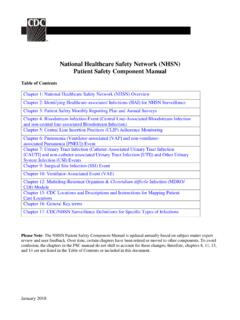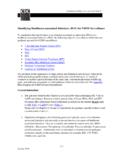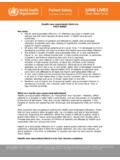Transcription of Identifying Healthcare-associated Infections (HAI) for ...
1 2- 1 January, 2015 Identifying Healthcare-associated Infections Identifying Healthcare-associated Infections (HAI) for NHSN Surveillance To standardize the classification of an infection as present on admission (POA) or a Healthcare-associated infection (HAI), the following objective surveillance definitions and guidance will be used for NHSN surveillance: 7- day Infection Window Period Date of Event POA HAI 14-day Repeat Infection Timeframe (RIT) Secondary Bloodstream Infection Attribution Period Pathogen Assignment Guidance These changes address a variety of scenarios to include repeat Infections of the same type, concurrent Infections of differing types, and pathogen assignment in multi-pathogen Infections .
2 These new approaches are intended to align criteria and definitions and decrease subjectivity while maintaining epidemiologic standardization and clinical relevance. Notes: Infection window period, POA, HAI, and RIT and secondary bloodstream infection attribution period definitions do not apply to SSI, VAE, or LabID Events. (Secondary BSIs may be attributed to SSI events. For guidance specific to SSIs see Secondary BSI Attribution Period and the SSI and BSI protocols). Date of Event, as defined in this chapter, does not apply to VAE or LabID Events; however, it is used to identify SSI. Table 1: Definition Application SSI LabID VAE Infection Window Period N/A Not Applicable Not Applicable Date of Event Yes POA N/A HAI N/A Repeat Infection Timeframe (RIT) N/A Secondary BSI Attribution Period * *See SSI specific guidance; N/A=Not Applicable 2- 2 January, 2015 Identifying Healthcare-associated Infections Observation Patients in Inpatient Locations: For purposes of NHSN surveillance, if an observation patient is sent to an inpatient location, the patient must be included in infection surveillance, patient day, and device day counts.
3 The facility assignment of the patient as an observation patient or an inpatient has no bearing in this instance for counting purposes. The patient is being housed, monitored, and cared for in an inpatient location and therefore is at risk for acquisition of an HAI. NHSN Infection Window Period: The NHSN Infection Window Period is defined as the 7-days during which all site-specific infection criteria must be met. It includes the day the first positive diagnostic test that is an element of the site-specific infection criterion, was obtained, the 3 calendar days before and the 3 calendar days after. For purposes of defining the Infection Window Period the following are considered diagnostic tests: laboratory specimen collection imaging test procedure or exam physician diagnosis initiation of treatment For site-specific infection criteria that do not include a diagnostic test, the first documented localized sign or symptom that is an element of NHSN infection criterion should be used to define the window ( , diarrhea, site specific pain, purulent exudate).
4 With the introduction of the Infection Window Period, gap days , used in 2014, will no longer be used to determine fulfillment of infection criteria. Table 2: Infection Window Period Infection Window Period 3 days before First positive diagnostic test OR First documented localized sign and/or symptom in the absence of a diagnostic test 3 days after 2- 3 January, 2015 Identifying Healthcare-associated Infections Date of Event (Event Date): The Date of Event is the date the first element used to meet an NHSN site-specific infection criterion occurs for the first time within the seven-day infection window period. An infection is considered Present on Admission (POA) if the date of event of the NHSN site-specific infection criterion occurs during the POA time period, which is defined as the day of admission to an inpatient location (calendar day 1), the 2 days before admission, and the calendar day after admission.
5 For purposes of NHSN surveillance and determination of the Repeat Infection Timeframe (as defined below) if the date of event is determined to be either of the two days prior to inpatient admission, then the date of event will be hospital day 1. An infection is considered a Healthcare-associated Infection (HAI) if the date of event of the NHSN site-specific infection criterion occurs on or after the 3rd calendar day of admission to an inpatient location where day of admission is calendar day 1. Table 3: Date of Event and Classification Determination Hospital Day Date of Event Assignment for RIT Classification 2 days before admit Hospital Day 1 POA 1 day before admit Hospital Day 1 1 Hospital Day 1 2 Hospital Day 2 3 Hospital Day 3 HAI 4 Hospital Day 4 5 Hospital Day 5 2- 4 January, 2015 Identifying Healthcare-associated Infections Table 4: Infection Window Period and Date of Event Notes.
6 Acceptable documentation includes patient-reported signs or symptoms documented in the chart by a healthcare professional ( , patients states measured fever > C or F, nursing home documents fever prior to arrival to the hospital, patient complains of dysuria). Physician diagnosis can be accepted as evidence of an infection only when physician diagnosis is an element of the specific infection definition. For example, physician diagnosis is not an element of any UTI criteria; therefore, physician diagnosis of a UTI may not be used to satisfy POA status of a UTI. Infections occurring in newborns with date of event on hospital day 1 or day 2 are considered POA. Those with date of event on day 3 or later are HAI.
7 This would include Infections acquired transplacentally ( , herpes simplex, toxoplasmosis, rubella, cytomegalovirus, or syphilis) or as a result from passage through the birth canal ( , Group B Streptococcus). Reactivation of a latent infection ( , herpes zoster [shingles], herpes simplex, syphilis, or tuberculosis) is not considered to be HAI. 2- 5 January, 2015 Identifying Healthcare-associated Infections Repeat Infection Timeframe (RIT): The RIT is a 14-day timeframe during which no new Infections of the same type are reported. The date of event is Day 1 of the 14-day RIT. Additional pathogens recovered during the RIT from the same type of infection are added to the event.
8 The RIT will apply at the level of specific type of infection with the exception of BSI, UTI, and PNEU where the RIT will apply at the major type of infection. Specific Type Example: Patients will have no more than one BONE infection in an RIT, but may have a BONE and DISC in two overlapping RITs (specific type) Major Type Examples: Patients will have no more than one LCBI in an RIT ( , LCBI 1, LCBI 2, MBI-LCBI 1, etc.) Patients will have no more than one PNEU in an RIT ( , PNU1, PNU2, PNU3) Patients will have no more than one UTI in an RIT ( , SUTI, ABUTI) The RIT applies during a patient s single admission, including the day of discharge and the day after, in keeping with the Transfer Rule.
9 2- 6 January, 2015 Identifying Healthcare-associated Infections In the example below (Table 5), the Date of Event is hospital day 4. The 14-day RIT is hospital day 4 through day 17. On hospital day 12, within the RIT, a urine culture with > 100,000 cfu/ml S. aureus is identified. The urine pathogen identified from the hospital day 12 culture is added to the original infection reported on day 4. Determination of a new infection or continuation of ongoing infection is not required. Table 5: Repeat Infection Timeframe Notes: A patient may have negative cultures during the RIT without impact on the RIT. Do not change the device-association determination during the RIT.
10 O Example: A non-catheterized UTI is identified and initiates an RIT. During the RIT, a Foley catheter is placed and more than 2 days later, still in the RIT, another urine culture is collected and reported positive for > 100,000 cfu/ml with a different bacteria. Add this pathogen to the original UTI but do not change the non-catheter associated UTI to CAUTI. 2- 7 January, 2015 Identifying Healthcare-associated Infections Secondary BSI Attribution Period (Refer to Appendix 1, Secondary BSI Guide of the BSI Event Protocol): The Secondary BSI Attribution Period* is the period in which a positive blood culture must be collected to be considered as a secondary bloodstream infection to a primary site infection.






